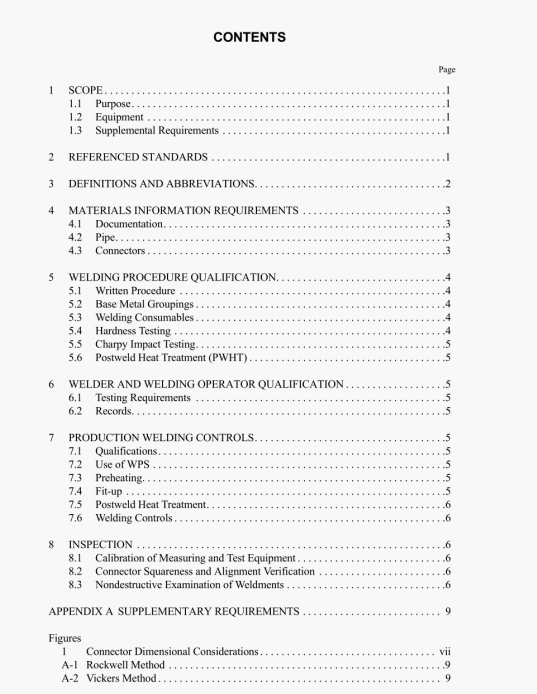API RP 5C6:2006 pdf download.Welding Connections to Pipe.
3 Definitions and Abbreviations
3.1 alignment: Refer to Section 8 of this document.
3.2 API: American Petroleum Institute.
3.3 ASME: American Socicty for Mechanical Engineers.
3.4 ASTM: American Socicty for Testing and Materials.
3.5 AWS: American Welding Society.
3.6 axial alignment: Alignment to within specified tolerances of the connector centerline, to the centerline of the connector at the opposite end of the pipe.
3.7 base metal: Metal to be welded or cut
3.8 base metal grouping: System used to describe comparable base metal characteristics such as chemical composition, weldability. thermal processing. and mechanical properties.
3.9 calibration: Comparison and adjustnicnt of instruments to a standard of known accuracy.
3.10 carbon equivalent: Equation where variables are defined by base metal composition. The resuk is used as infonnation to help assess the base metal wcldability.
3.11 casing: Steel pipe used in oil wells to seal off fluids from the bore and to prevent the walls of the hole from sloughing off or caving.
3.12 connector: Forging, machined to a geometry to function as a mechanical connection welded to pipe or casing. Other materials may be used if approved by purchaser.
3.13 connector parallelism: A measure of the connector face or plane with respect to the connector face at the opposite end of the pipe.
3.14 CVN impact test: Charpy V-notch impact testing in accordance with ASTM A370.
3.15 dIscontinuity: An interruption of the typical structure of a weldment such as lack of homogeneity in the mechanical, metallurgical. or physical characteristics. A discontinuity is not necessarily a defect.
3.16 drift mandrel: A precision dimensioned cylinder si7ed to pass through or be inserted into the ends of pipe. It is passed through or into the pipe end ID to locate obstructions or to assure compliance with appropriate specifications. Other drift configurations shall be approved by purchaser.
3.17 fabricator: The company responsible for welding.
3.18 grinding: Removing material from a pipe surface or weld by abrading. e.g.. grinding wheel,
3.19 hardness test: A measure of the hardness of a metal, as determined by pressing a hard steel ball or diamond penetrant
into a smooth surface under standard conditions. Results are often expressed in terms of Rockwell hardness number (HRH or
H RC) or Brinell Hardness Number (HHN). Refer to the latest editions of ASTM El 0 and ASTM F. IX for added information.
3.20 heat affected zone (HAZ): Base metal zone adjacent to a weld that has had a metallurgical change induced by welding.
3.21 manufacturer: ‘(‘he company that manufactures the connector.
3.22 magnetic particle examination: A nondestructive test method utilizing magnetic flux leakage fields and suitable indicating materials to disclose surface and near-surface discontinuity indications.
3.23 NACE: National Association of Corrosion Engineers, previously NACE. now NACE International, Inc.
3.24 nondestructive exam (NDE): Inspection to detect internal, surface, and concealed defects or flaws in materials using techniques that do not damage or destroy the items being tested,
3.25 pipe: In this document refers to plain end pipe to which connectors are to be welded.
3.26 postweld heat treat (PWHT): Thermal heat treatment applied at the completion of a weld as specified on the welding procedure specification.
API RP 5C6:2006 pdf download
